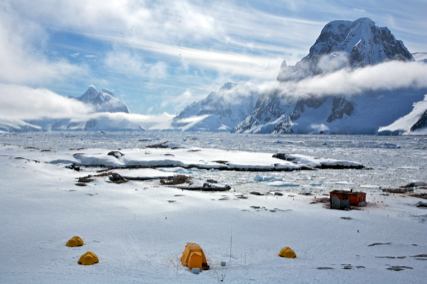|
Adélies losing ground while gentoos thriving in study areaTicks from the genus Ixodes are also stressing penguins during their breeding season, according to Naveen. His team noted their presence a couple of years ago, and there are reports of ticks on penguins at Arthur Harbor, about 40 kilometers north of Petermann Island. “It’s a terrible thing to see,” Naveen said. “The ticks get into the adult penguins’ feathers. The penguins start scratching. They stop paying attention to the eggs … We don’t have an answer to this question yet about the timing of it all.” In addition to being an annoyance, the ticks potentially carry disease. All of those factors add up to steep declines in Adélie populations. In 1909, when French explorer Jean-Baptiste Charcot wintered on Petermann, the population of Adélies included 925 breeding pairs with only about 50 breeding pairs of gentoos, which belong to the same genus Pygoscelis. “There’s been a total flip in population size since then over a century,” Naveen said. Adélies are down to fewer than 400 pairs, while gentoos are thriving, with more than 2,700 pairs. “This correlates quite specifically to temperature data in the region.” Other researchers in the region are coming up with similar results for the different populations. Bill Fraser, president of the Montana-based nonprofit Polar Oceans Research Group, has studied seabirds in the region for more than 30 years. Fraser said he and his team with the NSF-funded Palmer Long Term Ecological Research The gentoos, on the other hand, are enjoying the new subantarctic conditions that appear to be migrating south down the peninsula. A subantarctic species, gentoos are also able to dive deeper than their Adélie cousins and subsist on a more varied diet. They’re also bigger than Adélies — and apparently willing to bully where necessary. “At Petermann, I’ve seen gentoos push Adélies off of nesting rocks and just take over,” Naveen said. “Size is a factor.” The status of the third of the living Pygoscelis, or brush-tailed, penguins, is a “mixed bag,” according to Naveen. Chinstraps are doing well in some areas while declining in others, he said. Naveen and the Fagan Lab just received another five-year grant award from NSF’s Office Of Polar Programs “It’s quite an amazing cooperative effort,” Naveen said. “I’m not aware of anywhere else in the world where science and ecotourism cooperate so extensively.” Jennifer Gregoire, a spokesperson for the Lindblad Expeditions “The work with Oceanites is really great because our guests have the opportunity to interact with the researchers, learn about the project that they’re doing, and sometimes our guests are even able to participate in tasks like counting penguins,” she said. The eco cruise company has 18 departures planned to Antarctica next season aboard two ships, the National Geographic Explorer and the National Geographic Endeavor. An estimated 34,000 tourists visited Antarctica during the 2007-08 austral summer. One of the uses of the data from the Antarctic Site Inventory is to study the effects of tourism on the continent. But tourism is only one dimension to the Antarctic Site Inventory. Lynch is hopeful she’ll have the first iteration of a model completed in the next year or two that will give researchers a better idea of what makes some species like Adélies losers and gentoos winners in the climate change game. “I think of it as being a process,” she said. “It will be a continuing conversation about what is going on in the peninsula.” NSF-funded research in this story: Ron Naveen, Oceanites Inc., Award No. 0739430; William Fagan and Heather Lynch, University Of Maryland, Award No. 0739515; Bill Fraser, Polar Oceans Research Group, Award No. 0523261. |



For USAP Participants |
For The Public |
For Researchers and EducatorsContact UsU.S. National Science FoundationOffice of Polar Programs Geosciences Directorate 2415 Eisenhower Avenue, Suite W7100 Alexandria, VA 22314 Sign up for the NSF Office of Polar Programs newsletter and events. Feedback Form |




